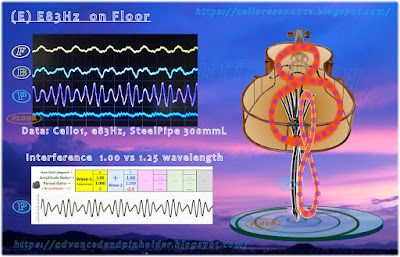[ 2/03/2022 ] Labels: 53.Endpin-Resonance3
This post is the last report on Endpin-Resonance study series, commented on low tones E(83Hz)-F(88Hz) on C string.
We can see two typical resonance patterns in this area. Sometimes harsh influence to floor is observed on this spot.
The first pattern is the same as being seen at C-D tone(:accompanied with interference beats). For example, interference between E(83Hz, 4.11m-wavelength) and 'E + endpin length'(: 4.1 + 1.0 = 5.1m :redundant wavelength ) was sometimes seen on the endpin.
The second pattern relates to endpin's two-ends resonance. In this case, for instance, rather narrow F(88Hz) resonance orbit shifts the resonance angle along backward and forward in the cello body, then endpin delivers the swing to its two ends. This physical vibration sometimes seems bringing harsh impacts to the floor.
エンドピン共振の一連の調査の最終として、C線の E(83Hz)-F(88Hz)付近についてまとめる。
エンドピンの振動が床に伝わっている第2のスポットである。ここでは特徴的な二つの振動パターンが見られる。
第一は C-D音で見られたのと同様なきつい干渉振動がエンドピンに観察される場合であり、第二はにエンドピンの中央はほとんど振幅が無いのにピン先(正確には両端)で大きな振動となり床を叩いているような場合である。
第一の干渉が起こっている場合は、例えば E と E+1.0m の二つの波長(振動数)が干渉している。つまり、エンドピンの全長が加わった(ピッチが大幅に下がった)波長・ルートが存在する。
第二の場合は、筐体内で 2ビートで共振する8の字軌道(=波長が短くなるので、振動方向が筐体の前後方向に移ってきている)に物理的に共振してエンドピンの両端も2ビートで前後方向に共振している場合である。この時の床への衝撃は大きい。


